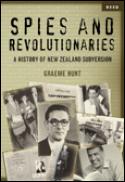Graeme Hunt's Book on New Zealand Spies and Revolutionaries – Chapter Three: Karl Marx's legacy
Scoop is serializing the first 1000 words of each chapter of author Graeme Hunt's latest book: Spies And Revolutionaries – A History of New Zealand Subversion. Click here for Chapter Three: Karl Marx's legacy
 The history of New Zealand's intelligence agencies and
those it has spied on have been laid bare in a book by
Auckland-based journalist, author, and historian Graeme
Hunt.
The history of New Zealand's intelligence agencies and
those it has spied on have been laid bare in a book by
Auckland-based journalist, author, and historian Graeme
Hunt.
Spies And Revolutionaries – A History of New Zealand Subversion details how several prominent New Zealanders, all of whom are dead, spied for the former Soviet Union during the Cold War. Accusations and suspicions are laid bare before files and information that has never before been made public. This book will clearly recharge debate as to whether Dr Bill Sutch, diplomat Paddy Costello, and public servant Ian Milner were spies acting against New Zealand's national interest.
CHAPTER THREE: Karl Marx's legacy
 New Zealanders have long dabbled in economic, political and
social radicalism and it is no surprise that some were early
supporters of the prophets of communism, Karl Marx and
Friedrich Engels. The first communist-inspired public
demonstration in New Zealand was in January 1871 when up to
600 people, many of them unemployed, met at Cathedral
Square, Christchurch, to form the Canterbury Working Men’s
Mutual Protection Society. It followed a meeting in the city
eight months earlier at which the organisers demanded
constant employment for those already in the province before
new migrants were allowed in.
New Zealanders have long dabbled in economic, political and
social radicalism and it is no surprise that some were early
supporters of the prophets of communism, Karl Marx and
Friedrich Engels. The first communist-inspired public
demonstration in New Zealand was in January 1871 when up to
600 people, many of them unemployed, met at Cathedral
Square, Christchurch, to form the Canterbury Working Men’s
Mutual Protection Society. It followed a meeting in the city
eight months earlier at which the organisers demanded
constant employment for those already in the province before
new migrants were allowed in.
But this latest meeting was different from past protests by jobless immigrants; it was a call to change the political order, and Marx and Engels soon got to hear about it. On 12 March 1872 the society, by its own initiative, became a branch of Marx and Engels’ London-based International Working Men’s Association, otherwise known as the First International, which had been formed eight years earlier. The society withered when the Canterbury economy picked up but the stain of Marx and Engels remained to be venerated by small groups of believers over the next four generations.
The word ‘communism’, borrowed by Marx and Engels in 1843 from the French communisme and immortalised in their 1848 Communist Manifesto,1 probably entered the New Zealand lexicon at about the time the Canterbury society was formed but it did not come into popular use until after 1918 when the Bolshevik Party, which had seized power in Russia the previous year, changed its name to the All-Russian Communist Party (Bolsheviks). What is certain is that communism grew in stature in 1871 when a disparate group of Parisians, appalled by their provisional government’s submission to humiliating peace terms imposed by the Prussians after the Franco–Prussian War, rebelled in the name of the Commune of Paris.2 It was an uprising but one with little in common with Marx and Engels’ vision of the proletariat seizing the reins of the state. Within a few weeks the communards were crushed by the provisional government and France returned steadily to a normal (capitalist) state. But the myth of a workers’ revolution remained, helped unwittingly by supporters of the new French president, Adolphe Thiers, who blamed the uprising on a conspiracy led by Marx and Engels’ International Working Men’s Association. This served only to spread fear of communism among the emerging middle classes and conservative governments of continental Europe and beyond.
Just how the members of the Canterbury Working Men’s Mutual Protection Society related to this Marxian3 ‘conspiracy’ is not clear but the evidence suggests that literate labourers and artisans were willing to debate important issues of the day, including ‘internationalist’ solutions to improve the lot of working people. The leader of the Canterbury society, farm labourer James McPherson, even produced a pamphlet, Reasons Why the Working Men of New Zealand Should Become Internationalist (also containing an article titled ‘Anti-Chinese Immigration’), to assist his proselytising. Although technically a communist, McPherson was following a well-trodden path of working people in New Zealand demanding a better deal. Carpenter Samuel Parnell started the move when he arrived in Petone in 1840 by refusing to work more than eight hours a day. A demand for shorter Saturday working hours was taken up in Auckland in 1851 by a painter, William Griffin, who had been a Chartist –– an advocate of the radical People’s Charter –– in Britain. In 1857 he launched a successful campaign for an eight-hour day in Auckland and shortly before his death in 1870 he extended the eight-hour day to the Thames goldfield. In 1899 the eight-hour day was commemorated officially when Parliament, dominated by Richard Seddon’s Liberal Party, established Labour Day as a public holiday. It had been a ‘demonstration day’ observed by unions since 1890.
Seddon and his party could hardly be described as crypto-communists. But they were influenced heavily by the reformist Fabian Society (established in London in 1884 and in New Zealand in 1896), itself swayed by the doctrines of Marx and Engels, if not their commitment to an international workers’ revolution. Other commentators also left their mark, in particular English philosopher John Stuart Mill and American economist Henry George, both of whom favoured taxing the ‘unearned increment’ of land value increases to address social and economic ills, beliefs that led to a New Zealand government in 1878 imposing land tax and efforts by later governments to break up big estates to end the so-called ‘land monopoly’ and eliminate ‘privilege’.
These international influences also helped shape the embryonic trade union movement, not least the establishment of the ‘radical progressive’ Knights of Labour4 order in New Zealand in 1887 and the Maritime Council of New Zealand nearly two years later. The success of the industrial and social reform programmes of Seddon’s Liberals, containing much of the Knights’ policy, blunted the order’s growth and it was extinct in New Zealand by 1900; the Maritime Council, exhausted by a disastrous strike, did not live beyond 1890. But ideas survive organisations and the seeds of radicalism were to reappear in the early twentieth century.
Ironically, it was the economic boom in the run-up to World War I that was the catalyst for industrial militancy and the spread of radicalism. The bedrock Industrial Conciliation and Arbitration Act (IC&A Act), passed in 1894, and a range of other state measures benefiting workers and their families, started to lose their appeal as wage-earners struggled to keep pace with the cost of living. The arbitration system in particular, which had served New Zealand well in the 1890s, came under increasing attack because of its bureaucracy and slowness. The result was that some unionists took matters into their own hands.
See Also:
Scoop is serializing the first 1000 words of each chapter of author Graeme Hunt's latest book: Spies And Revolutionaries – A History of New Zealand Subversion.
SRP: $29.99
ISBN:
9780790011400
340p, includes index, black and white
photos
Reed Publishing (NZ) Ltd www.reed.co.nz
Release: August 6 2007
For more, see… Reed Publishers, Spies And
Revolutionaries



 Eugene Doyle: The Fall Of Saigon 1975 - Fifty Years Of Repeating What Was Forgotten
Eugene Doyle: The Fall Of Saigon 1975 - Fifty Years Of Repeating What Was Forgotten Peter Dunne: Dunne's Weekly - Trump's Tariffs Still Pose Risks For New Zealand
Peter Dunne: Dunne's Weekly - Trump's Tariffs Still Pose Risks For New Zealand Keith Rankin: Barbecued Hamburgers And Churchill's Bestie
Keith Rankin: Barbecued Hamburgers And Churchill's Bestie Gordon Campbell: On Why The US Stands To Lose The Tariff Wars
Gordon Campbell: On Why The US Stands To Lose The Tariff Wars Eugene Doyle: Before It’s Too Late - Reimagine New Zealand’s Military Future
Eugene Doyle: Before It’s Too Late - Reimagine New Zealand’s Military Future  Binoy Kampmark: Gender Stunts In Space - Blue Origin’s Female Celebrity Envoys
Binoy Kampmark: Gender Stunts In Space - Blue Origin’s Female Celebrity Envoys